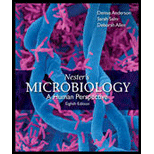
Concept explainers
How is preservation different from pasteurization?
To review:
The difference between the preservation and the pasteurization.
Introduction:
Microorganisms are found in every possible place and environmental conditionals like air, water, hot springs, deep thermal vents, and in saline conditions. They are microscopic and can grow rapidly. However, it becomes crucial in some cases, such as in food, medicines, and in open wounds where these microbes need to get rid off in order to eliminate the chances of infections and diseases. Thus, several methods of sterilization and preventive are available so as to destroy or prevent their spread.
Explanation of Solution
Various measures including physical, chemical, or a combination of both are employed to control or prevent the microbial growth at the unwanted places. The physical methods comprise washing, irradiation, filtration, and heat treatment, whereas the chemical methods include the use of various chemicals, disinfectants, and other drugs to kill the microbes and thus, prevent their growth. The main processes followed to control the microbial growth are:sterilization, disinfection, preservation, and pasteurization.
The main difference between the preservation and the pasteurization is tabulated as follows:
| Preservation | Pasteurization |
| (1) It refers to the process of delaying the spoilage of the products which can get decay fast (perishable items) such as vegetables. | (1) This refers to the heat treatment for a short period of time without changing the properties of the materials as it increases the shelf-life of the product. |
| (2) This can be done by storing the materials at cold temperatures or by adding preservatives. | (2) The most used pasteurization is high-temperature short-time (HTST) for milk. Other than this, ultra-high-temperature (UHT) pasteurization is also used for juices and wine. |
| (3) They have the bacteriostatic effect, that is, they inhibit the microbial growth without killing them. | (3) In this method, most of the microbes responsible for spoilage are killed and are reduced in number too. |
Therefore, the methods of preservation and pasteurization are used to control the spoilage of food material due to the growth of microbes. Preservation includes inhibition of their growth without killing them, whereas pasteurization is the killing of the microbes by a heat treatment for a short time.
Want to see more full solutions like this?
Chapter 5 Solutions
Nester's Microbiology: A Human Perspective
- We will be starting a group project next week where you and your group will research and ultimately present on a current research article related to the biology of a pathogen that infects humans. The article could be about the pathogen itself, the disease process related to the pathogen, the immune response to the pathogen, vaccines or treatments that affect the pathogen, or other biology-related study about the pathogen. I recommend that you choose a pathogen that is currently interesting to researchers, so that you will be able to find plenty of articles about it. Avoid choosing a historical disease that no longer circulates. List 3 possible pathogens or diseases that you might want to do for your group project.arrow_forwardnot use ai pleasearrow_forwardDNK dagi nukleotidlar va undan sintezlangan oqsildagi peptid boglar farqi 901 taga teng bo'lib undagi A jami H boglardan 6,5 marta kam bo'lsa DNK dagi jami H bog‘lar sonini topingarrow_forward
- One of the ways for a cell to generate ATP is through the oxidative phosphorylation. In oxidative phosphorylation 3 ATP are produced from every one NADH molecule. In respiration, every glucose molecule produces 10 NADH molecules. If a cell is growing on 5 glucose molecules, how much ATP can be produced using oxidative phosphorylation/aerobic respiration?arrow_forwardIf a cell is growing on 5 glucose molecules, how much ATP can be produced using oxidative phosphorylation/aerobic respiration?arrow_forwardHow do i know which way the arrows go?arrow_forward
- Identify the indicated structure (Saprolegnia). a. antheridium O b. oospore c.sperm d. auxospore e. tetraspore Of. zygosporearrow_forwardUsing information from the primary literature (several references have been provided as a starting point below) please answer the following question: Based on your review of the literature on rewilding, what are the major scientific pros and cons for rewilding? Please note that the focus of this assignment are the (biological) scientific issues associated with rewilding. As will be discussed in class, there are a number of non-scientific issues involved or implicated in rewilding, all ultimately affecting the public acceptability of rewilding. Although these issues are important – indeed, critical – in this assignment you should focus on the biological science issues and questions. Details: You must enumerate at least two pros and at least two cons. Your answer should be no more than 500 well-chosen words, excluding references. Think carefully about how best to organize and structure your answer. Aim for high information density: say a lot, but say it succinctly. Recall Nietzche’s…arrow_forwardUsing information from the primary literature (several references have been provided as a starting point below) please answer the following question: Based on your review of the literature on rewilding, what are the major scientific pros and cons for rewilding? Please note that the focus of this assignment are the (biological) scientific issues associated with rewilding. As will be discussed in class, there are a number of non-scientific issues involved or implicated in rewilding, all ultimately affecting the public acceptability of rewilding. Although these issues are important – indeed, critical – in this assignment you should focus on the biological science issues and questions. Details: You must enumerate at least two pros and at least two cons. Your answer should be no more than 500 well-chosen words, excluding references. Think carefully about how best to organize and structure your answer. Aim for high information density: say a lot, but say it succinctly. Recall Nietzche’s…arrow_forward
 Principles Of Radiographic Imaging: An Art And A ...Health & NutritionISBN:9781337711067Author:Richard R. Carlton, Arlene M. Adler, Vesna BalacPublisher:Cengage LearningEssentials Health Info Management Principles/Prac...Health & NutritionISBN:9780357191651Author:BowiePublisher:Cengage
Principles Of Radiographic Imaging: An Art And A ...Health & NutritionISBN:9781337711067Author:Richard R. Carlton, Arlene M. Adler, Vesna BalacPublisher:Cengage LearningEssentials Health Info Management Principles/Prac...Health & NutritionISBN:9780357191651Author:BowiePublisher:Cengage





